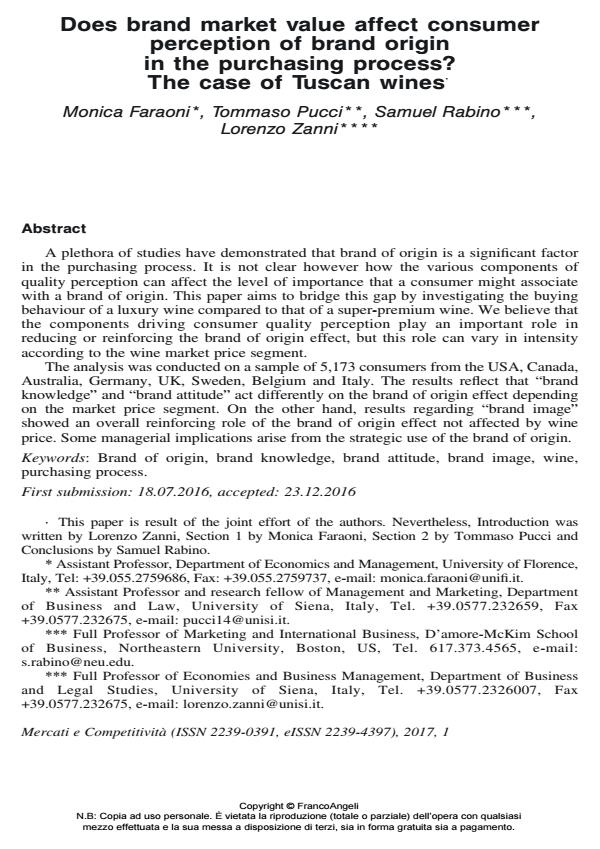Does brand market value affect consumer perception of brand origin in the purchasing process? The case of Tuscan wines
Titolo Rivista MERCATI & COMPETITIVITÀ
Autori/Curatori Monica Faraoni, Tommaso Pucci, Samuel Rabino, Lorenzo Zanni
Anno di pubblicazione 2017 Fascicolo 2017/1
Lingua Inglese Numero pagine 28 P. 51-78 Dimensione file 193 KB
DOI 10.3280/MC2017-001004
Il DOI è il codice a barre della proprietà intellettuale: per saperne di più
clicca qui
Qui sotto puoi vedere in anteprima la prima pagina di questo articolo.
Se questo articolo ti interessa, lo puoi acquistare (e scaricare in formato pdf) seguendo le facili indicazioni per acquistare il download credit. Acquista Download Credits per scaricare questo Articolo in formato PDF

FrancoAngeli è membro della Publishers International Linking Association, Inc (PILA)associazione indipendente e non profit per facilitare (attraverso i servizi tecnologici implementati da CrossRef.org) l’accesso degli studiosi ai contenuti digitali nelle pubblicazioni professionali e scientifiche
A plethora of studies have demonstrated that brand of origin is a significant factor in the purchasing process. It is not clear however how the various components of quality perception can affect the level of importance that a consumer might associate with a brand of origin. This paper aims to bridge this gap by investigating the buying behaviour of a luxury wine compared to that of a super-premium wine. We believe that the components driving consumer quality perception play an important role in reducing or reinforcing the brand of origin effect, but this role can vary in intensity according to the wine market price segment. The analysis was conducted on a sample of 5,173 consumers from the USA, Canada, Australia, Germany, UK, Sweden, Belgium and Italy. The results reflect that "brand knowledge" and "brand attitude" act differently on the brand of origin effect depending on the market price segment. On the other hand, results regarding "brand image" showed an overall reinforcing role of the brand of origin effect not affected by wine price. Some managerial implications arise from the strategic use of the brand of origin.
Parole chiave:Brand of origin, brand knowledge, brand attitude, brand image, wine, purchasing process.
- Comparison of three wine routes’ realities in Central Portugal Diana Cunha, Maria Lúcia Pato, Elisabeth Kastenholz, Cristina Barroco, in Open Agriculture 20220201/2023
DOI: 10.1515/opag-2022-0201 - Factores de incidencia en el consumo de alimentos con denominación de origen (DO) en México. Laura Elena Martínez Salvador, in Agricultura, Sociedad y Desarrollo /2023
DOI: 10.22231/asyd.v20i3.1420 - C’ing is believing: What types of characteristics are found on bottles of wine? Do more characteristics mean more online presence? Gregory Charles Zetzsche, John Dunning, in Research in Hospitality Management /2023 pp.121
DOI: 10.1080/22243534.2023.2277517 - Opportunities and challenges in the contribution of wine routes to wine tourism in Italy – A stakeholders' perspective of development Giuseppe Festa, S.M. Riad Shams, Gerardino Metallo, Maria Teresa Cuomo, in Tourism Management Perspectives 100585/2020 pp.100585
DOI: 10.1016/j.tmp.2019.100585 - Redes alimentarias alternativas para la valorización del patrimonio alimentario: propuesta analítica a partir de un estudio de caso Laura Elena Martínez Salvador, in Estudios Latinoamericanos /2023 pp.95
DOI: 10.22201/fcpys.24484946e.2022.50.85918
Monica Faraoni, Tommaso Pucci, Samuel Rabino, Lorenzo Zanni, Does brand market value affect consumer perception of brand origin in the purchasing process? The case of Tuscan wines in "MERCATI & COMPETITIVITÀ" 1/2017, pp 51-78, DOI: 10.3280/MC2017-001004